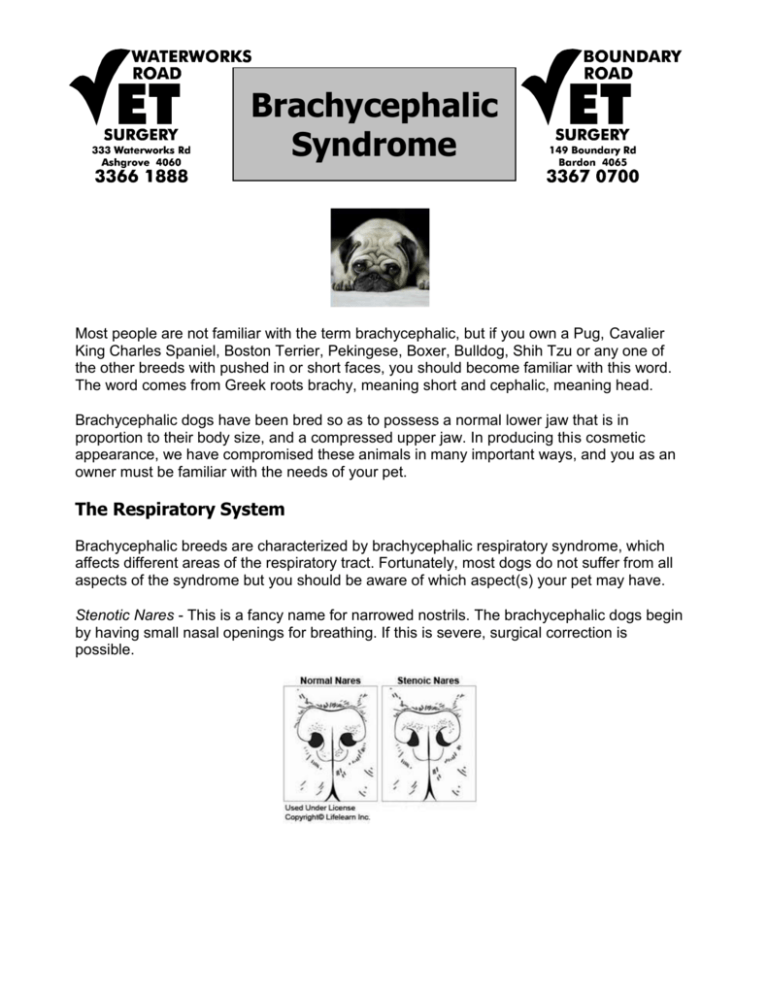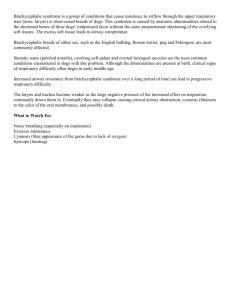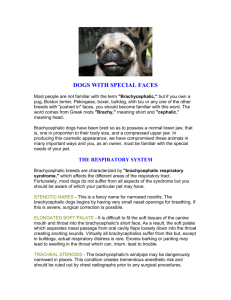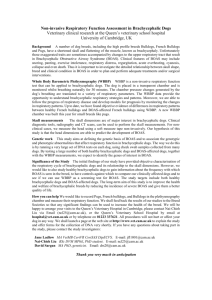Brachycephalic Syndrome - Waterworks Road Vet Surgery
advertisement

Brachycephalic Syndrome Most people are not familiar with the term brachycephalic, but if you own a Pug, Cavalier King Charles Spaniel, Boston Terrier, Pekingese, Boxer, Bulldog, Shih Tzu or any one of the other breeds with pushed in or short faces, you should become familiar with this word. The word comes from Greek roots brachy, meaning short and cephalic, meaning head. Brachycephalic dogs have been bred so as to possess a normal lower jaw that is in proportion to their body size, and a compressed upper jaw. In producing this cosmetic appearance, we have compromised these animals in many important ways, and you as an owner must be familiar with the needs of your pet. The Respiratory System Brachycephalic breeds are characterized by brachycephalic respiratory syndrome, which affects different areas of the respiratory tract. Fortunately, most dogs do not suffer from all aspects of the syndrome but you should be aware of which aspect(s) your pet may have. Stenotic Nares - This is a fancy name for narrowed nostrils. The brachycephalic dogs begin by having small nasal openings for breathing. If this is severe, surgical correction is possible. Brachycephalic Syndrome Elongated Soft Palate - It is difficult to fit the soft tissues of the canine mouth and throat into the brachycephalic‘s short face. As a result, the soft palate, which separates nasal passage from oral cavity, flaps loosely down into the throat, creating snorting sounds. This can result in severe respiratory distress (breathing problems), especially in summer. Excess barking or panting may lead to swelling in the throat which can, in turn, lead to trouble. Again, the soft palate can be surgically trimmed. Tracheal Stenosis - The brachycephalic dog's windpipe may be dangerously narrowed in places. This condition creates tremendous anesthetic risk and should be ruled out by chest radiographs prior to any surgical procedures. Everted Laryngeal Saccules - The normal larynx has two small pockets called ventricles or saccules. When a dog has increased effort in breathing, over time inside the throat these little pockets will actually turn inside out, making the windpipe narrower. When this occurs, the protuberances need to be surgically snipped. These are usually secondary problems that can be prevented by surgery to correct the stenotic nares and elongated soft palate. Heat Stress - Because of all these upper respiratory obstructions, the brachycephalic dog pants inefficiently. A dog with a more conventional face and throat is able to pass air quickly over the tongue through panting. Saliva evaporates from the tongue as air is passed across and the blood circulating through the tongue is efficiently cooled and circulated back to the rest of the body. In the brachycephalic dog, so much extra work is required to move the same amount of air that the airways become inflamed and swollen. This leads to a more severe obstruction, distress, and further over-heating. BRACHYCEPHALIC DOGS ARE THE MOST LIKELY CANDIDATES FOR HEAT STROKE. Altogether, the upper airway of the brachycephalic dog compromises the ability to take in air. Under normal conditions the compromise is not great enough to cause a problem; however, an owner should take care not to let the dog become grossly overweight or get too hot in the summer. Be aware of what degree of snorting and sputtering is usual for your pet, and should your dog require general anesthesia or sedation, your vet may want to take extra precautions or take radiographs beforehand to assess the severity of the syndrome. Anesthetic risk is higher than usual in these breeds, though under most circumstances the necessary extra precautions are readily managed by most animal hospitals. Brachycephalic Syndrome To be clear, brachycephalic syndrome can be progressive if it is not corrected at an early stage. Severely affected dogs can experience collapse of the larynx and require a permanent tracheostomy (a hole in the throat for breathing). Eye Problems With most of the nasal bones compacted, brachycephalic dogs tend to have trouble with the way their eyes sit in their heads. First, look at the prominence of the eyes on these dogs. The boney eye sockets are shallow. This means that any blow to the back of the head, even a fairly minor one, can cause an eye to pop from its socket and require surgical replacement. This can happen also with too much pulling against the leash if the dog is wearing a collar. You may wish to consider a harness for your pet. Sometimes, the eyes are so prominent that the lids cannot close all the way over the eyes. This will lead to irritation and drying of the center of the eye unless surgical correction is performed. If you cannot tell by watching your pet blink, watch as your pet sleeps. Dogs who sleep without closing their eyes all the way could use surgical correction. Eyelid problems are common in these breeds. Look for persistent wetness around the eyes. In some dogs, the shape of the eyelids prevents normal tear drainage and there is an overflow. This problem cannot be corrected surgically and is not uncomfortable for the pet; however, there is a more serious condition that looks similar. This second condition involves the rolling inward of the eyelids so that the lashes rub on the eye. Surgery may be needed to correct this problem. Chronic irritation will show as a pigmented area on the eye surface, especially on the side nearest the nose. This is hard to see without a bright light but if you notice it, a search for the cause is warranted. Depending on the location of the pigmentation, surgery may be recommended. Other Concerns The normal dog has 42 teeth in the mouth. The brachycephalic dog also has 42 teeth but a lot less space to fit them in. This means that the teeth will be crowded and growing in at odd angles which, in turn, traps food debris and leads to periodontal disease at a far younger age than in non-brachycephalic. The earlier you begin using home care dental products, the longer you will be able to postpone full dentistry under general anesthesia. Brachycephalic Syndrome Skin fold infections are common amid the facial folds of the brachycephalic breeds. Be sure to examine these areas periodically for redness. The broad-headed nature of these breeds makes reproduction a tricky matter as Caesarean section is frequently needed. Difficult labor is common and, as surgical assistance is often necessary, it is important not to breed females with tracheal stenosis (see above). Breeding is best left to the experts. Altogether, the brachycephalic breeds show plenty of personality and intelligence just as all dogs do but because of their specific needs, their owners need extra knowledge. If you have any questions about your brachycephalic dog, don't hesitate to call your veterinarian. http://www.acvs.org/AnimalOwners/HealthConditions/SmallAnimalTopics/BrachycephalicSyndrome/









